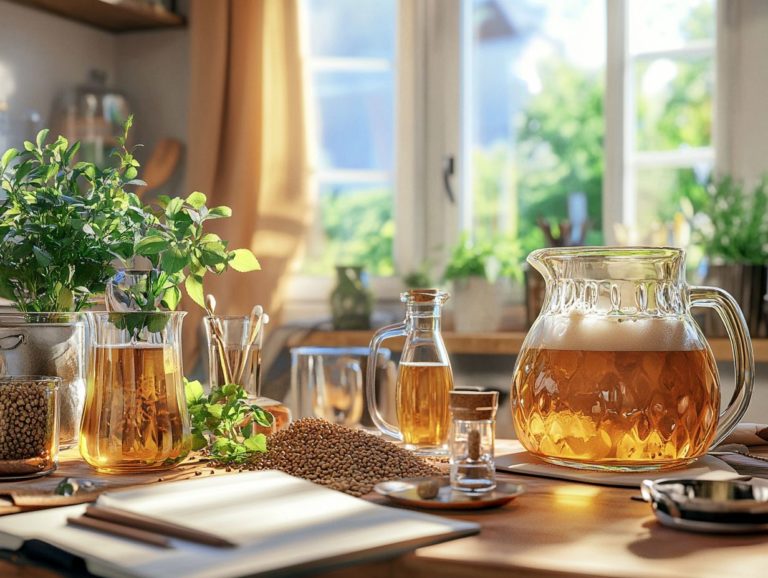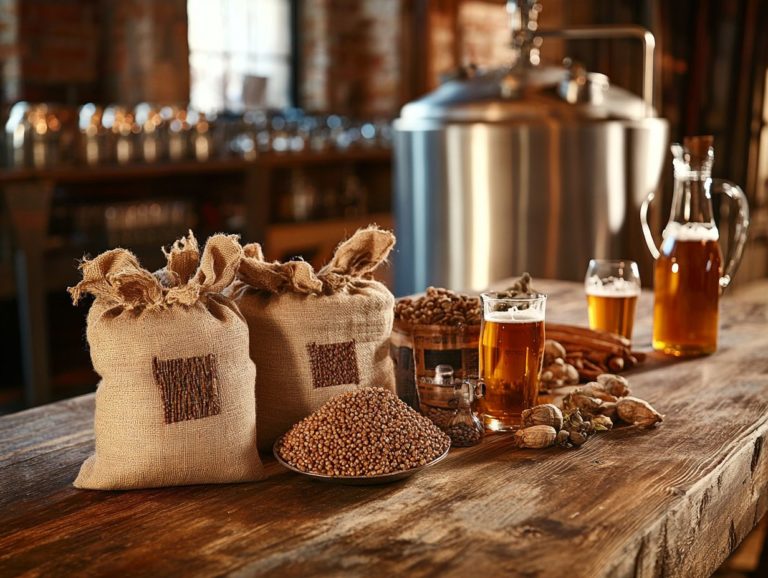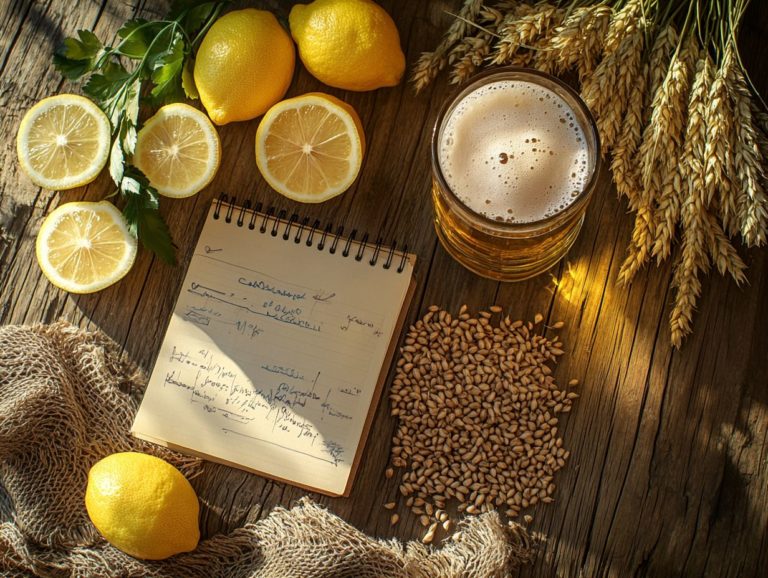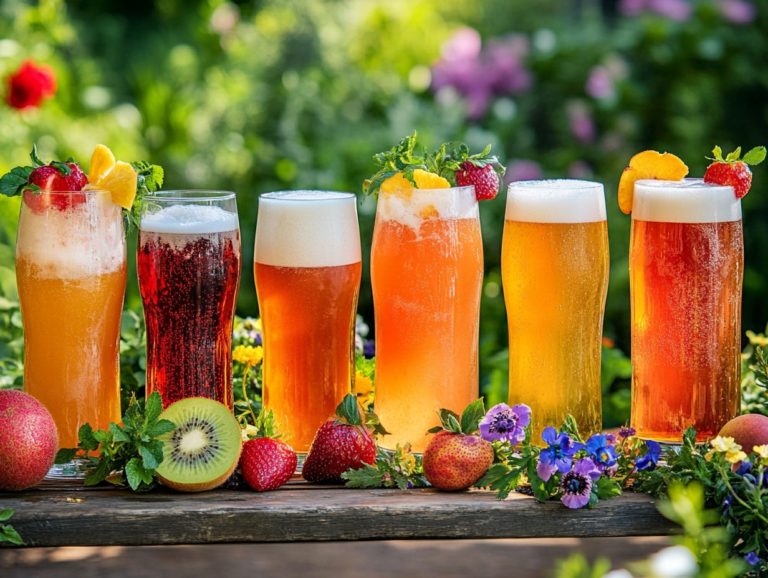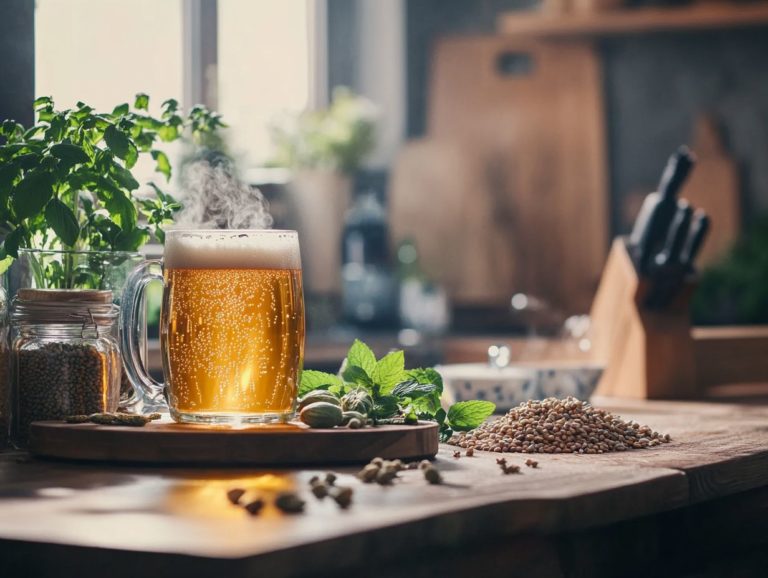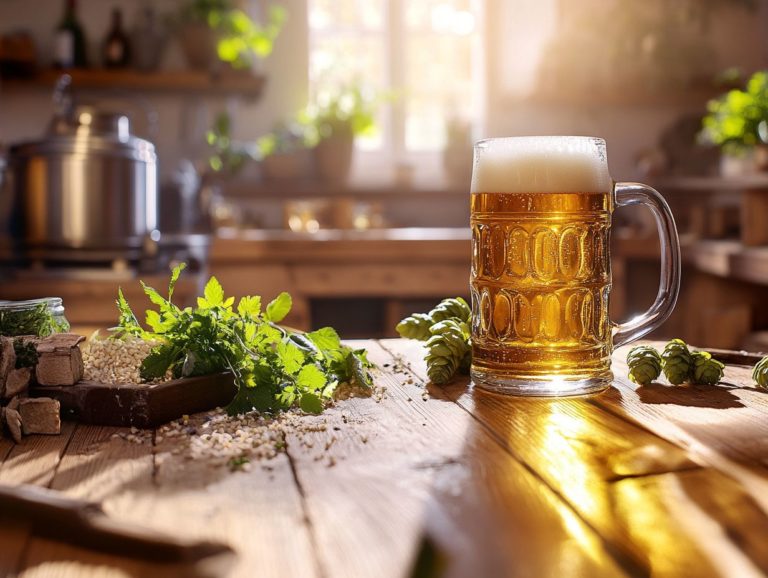The Best Craft Beer Recipes for Home Brewing
Home brewing transcends mere hobby status; it s a creative journey that empowers you to craft distinct flavors right in your own kitchen. From brewing methods to beer pairing, this pursuit encompasses a wide array of skills and knowledge.
This guide delves into the essence of home brewing, highlighting the numerous benefits it offers and detailing the essential brewing tools and equipment you ll need to embark on your brewing adventure.
You ll also find insights on selecting the finest beer ingredients, along with a step-by-step process for brewing beer at home. Get ready to dive into the exciting world of home brewing and enjoy the thrill of creating your own delicious beverages, whether they be craft beer or craft spirits!
Engage with the brewing community and participate in brewing workshops to further hone your skills. Attend beer festivals, taste various beer styles, and read beer reviews to expand your palate. Participate in homebrew challenges and attend festivals like the Minnesota Craft Beer Festival to boost your brewing skills. For advanced brewers, consider entering a homebrewing competition like the Knickerbocker Battle of the Brews.
Contents
- Key Takeaways:
- What Is Home Brewing?
- What Are the Benefits of Home Brewing?
- What Equipment Do You Need for Home Brewing?
- Brewing Essentials
- 3. Hops and Hop Varieties
- 4. Yeast and Yeast Selection
- 5. Water
- What Are the Steps to Home Brewing and Beer Brewing?
- What Are the Best Craft Beer Recipes for Home Brewing?
- Frequently Asked Questions
- What are the essential ingredients for brewing the best craft beer?
- How important is the water quality in crafting the perfect beer?
- What are some popular styles of craft beer that can be made at home?
- Do I need special equipment to brew craft beer at home?
- Can I adjust the alcohol content of my homemade craft beer?
- Is it possible to make non-alcoholic craft beer at home?
Key Takeaways:
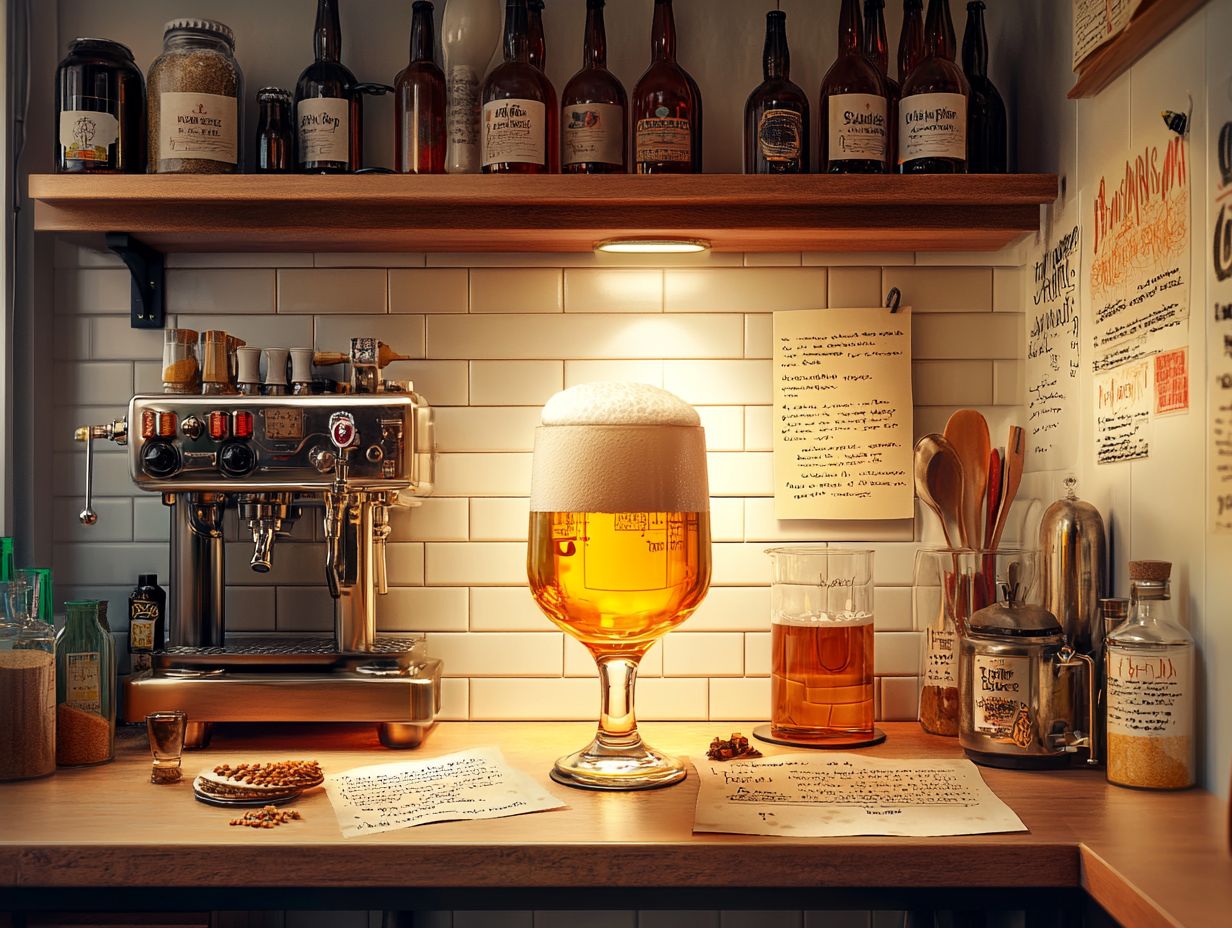
- Home brewing allows you to create unique and flavorful craft beer from the comfort of your home. Embrace brewing history as you dive into various beer styles and techniques.
- Investing in the right brewing equipment and carefully selecting high-quality ingredients will greatly impact the taste and success of your homebrewed beer.
- Some popular craft beer recipes for home brewing include IPA, Stout, Belgian Witbier, Pale Ale, and Hefeweizen. Experiment with different beer styles and brewing techniques to find your perfect brew.
What Is Home Brewing?
Home brewing is both an art and a science, allowing you to produce beer, cider, or other fermented beverages right in your own kitchen. This practice gives you the freedom to explore unique recipes tailored to your own taste preferences while immersing yourself in the rich history of craft beer and brewing chemistry.
As a home brewer, you ll find yourself using specific equipment and following brewing steps designed to help you create a variety of beer styles, from hoppy IPAs to decadent stouts, and even sour ales.
The home brewing community thrives on collaboration and knowledge sharing, offering a wealth of brewing courses, guides, and competitions that foster a vibrant atmosphere of innovation and creativity. Engaging in homebrew challenges and attending beer festivals can further enhance your brewing skills.
What Are the Benefits of Home Brewing?
Home brewing presents a wealth of benefits that go far beyond merely savoring a few pints of craft beer; it nurtures creativity, deepens your understanding of brewing techniques, and cultivates a vibrant brewing community of fellow enthusiasts.
As you immerse yourself in the art of homebrewing, you have the opportunity to experiment with various beer styles, refine your recipes, and delve into the fascinating intricacies of the fermentation process and brewing chemistry that bring your unique creations to life.
By participating in brewing competitions and joining homebrew clubs, you can share your masterpieces and receive invaluable feedback from fellow beer aficionados and beer judges, enriching your brewing journey further.
What Equipment Do You Need for Home Brewing?
Essential Equipment
To embark on your home brewing journey, having the right equipment is paramount. You’ll need specific tools and supplies that streamline every step of the process, from fermentation to carbonation. Understanding brewing efficiency and using brewing software can further optimize your homebrewing process.
Essential items like a fermentation vessel, airlock, and bung are vital for creating a controlled environment that supports yeast activity and fermentation temperatures. For proper storage of your finished craft beer, a bottling bucket and bottles are critical.
A hydrometer will become your best friend, allowing you to take gravity readings and closely monitor fermentation. A thermometer is equally important for maintaining ideal fermentation temperatures, while a wort chiller is crucial for rapidly cooling your wort post-boil, minimizing the risk of contamination. For those looking to refine their process, brewing notes and recipe adjustments can be invaluable.
Ready to start brewing? Gather your supplies and let the adventure begin!
Brewing Essentials
1. Fermentation Vessel
A fermentation vessel is a key element of your brewing toolkit. It provides a sealed environment where the magic of fermentation unfolds.
Here, yeast works its charm, converting sugars into alcohol and carbon dioxide. These vessels come in various styles, such as carboys, fermenters, and kegs, each bringing its own set of advantages tailored to different brewing needs.
Carboys, typically crafted from glass or plastic, are celebrated for their ability to minimize oxygen exposure a critical factor in preserving the integrity of your brew. Meanwhile, fermenters often boast a wider mouth, making cleaning a breeze. Some even come with built-in spigots for easy transferring.
Including malt extract in your recipes can further enhance the brewing process. The sizes of these vessels can range significantly, accommodating everything from petite batches to larger homebrews.
However, regardless of the type you choose, maintaining proper sanitation is paramount. This ensures you prevent contamination and promote a successful fermentation process that yields exceptional results.
2. Airlock and Bung
An airlock and bung are essential components of your fermentation setup. They create a barrier that allows carbon dioxide to escape while effectively keeping outside contaminants at bay.
This crucial function creates an anaerobic environment, which means without oxygen, essential for robust yeast activity and the production of high-quality beer. You’ll find airlocks in various designs, including the S-shaped, the 3-piece, and the bubbler airlock, each offering unique advantages in terms of efficiency and user-friendliness.
By using a bung alongside an airlock, you ensure a tight seal, significantly reducing the risk of unwanted exposure to air, bacteria, or wild yeast. This meticulous management of the fermentation process directly impacts the taste and aroma of your final product, as well as its overall stability. It underscores the importance of these components in the art of brewing.
Using brewing software to monitor these variables greatly enhances your brewing efficiency.
3. Bottling Bucket
A bottling bucket is an indispensable tool in your brewing arsenal. It streamlines the transition of beer from the fermentation vessel to bottles, ensuring a seamless process that minimizes oxidation and maintains beer carbonation.
Equipped with a spigot at the bottom, this critical piece of equipment allows you to control the flow of beer with ease. This significantly reduces the risk of splashing and the unwanted exposure to oxygen that can compromise flavor.
The graduated markings on the bucket provide clear volume indications, making it straightforward for you to achieve precise measurements during bottling. Utilizing brewing notes can help you track these details for future brewing sessions.
Paying close attention to detail can supercharge your brewing efficiency by promoting proper carbonation and ensuring consistent levels across all bottles. By utilizing a bottling bucket, you not only simplify the bottling process but also emphasize the importance of sound techniques in crafting a high-quality final product.
Now that you re equipped with the essentials, it s time to unleash your creativity and brew your own beer!
4. Bottles and Caps: Key Considerations
Choosing the right bottles and caps is essential for your home brewing success, as they play a pivotal role in maintaining your beer’s integrity during carbonation and storage. Proper beer brewing supplies, including caps and capping methods, are vital for maintaining the quality of your brew.
You’ll find various options for bottling, with glass and PET being the most popular materials. Glass bottles are often the preferred choice due to their resistance to oxygen infiltration. They offer a classic aesthetic and are reusable, providing a more sustainable option for the environmentally conscious brewer. However, their fragility and weight might not suit every brewing scenario.
PET bottles, while less prone to breakage, must be handled correctly to avoid flavor compromise. On the flip side, PET bottles are lightweight and virtually unbreakable, making them incredibly user-friendly. Yet, if not stored properly, they could compromise the beer’s flavor over time.
Understanding hop varieties and hop bitterness can further help in preserving the intended flavor profile of your brew. Remember, a secure cap is crucial for your brew s quality; it seals in carbonation and prevents spoilage, directly influencing the quality and shelf life of your beer.
Understanding these distinctions, along with making recipe adjustments, empowers you to keep your creations fresh and flavorful for much longer. Try different bottling methods and share your results with fellow brewers!
5. Hydrometer
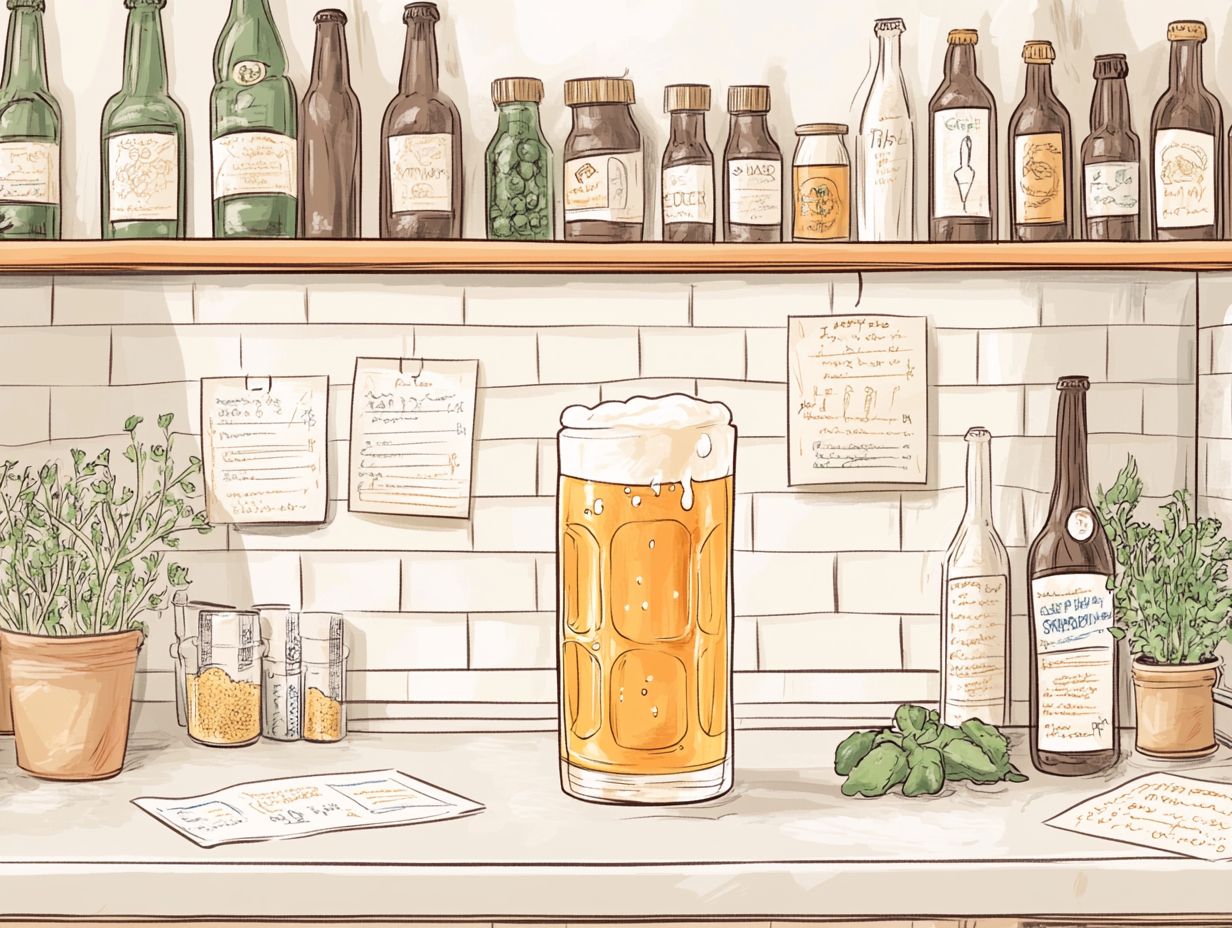
A hydrometer is an essential tool in your brewing arsenal, allowing you to measure the specific gravity (the density of your wort compared to water) of the wort both before and after fermentation. This small but mighty device provides crucial insights into the fermentation process and helps you estimate the potential alcohol by volume (ABV) (the percentage of alcohol in your beer).
Using a hydrometer helps you establish a baseline for your brew. By taking your initial readings, you establish the density of sugars present in the wort, which directly correlates to potential alcohol content. Subsequent measurements during fermentation reveal how effectively the yeast is transforming sugars into alcohol. Mastering this skill is crucial for achieving the desired beer flavor profiles.
Interpreting these gravity readings accurately not only helps you monitor fermentation progress but also offers invaluable feedback for fine-tuning your future recipes. Understanding specific gravity enables you to refine flavors, ensuring your brews align with your desired profiles and ultimately enhances the overall drinking experience. Leveraging brewing guides and keeping thorough brewing notes can also provide substantial aid in this regard.
6. Thermometer
A thermometer is an essential companion in your home brewing adventure, providing the precision needed for temperature control during critical phases, particularly during fermentation. Proper beer temperature control is essential for achieving the desired fermentation temperatures.
By understanding the different types of thermometers at your disposal, you can significantly elevate your ability to monitor and adjust temperatures effectively. For instance, digital thermometers offer quick and accurate readings, while infrared thermometers allow you to take non-contact surface temperature measurements with ease.
Maintaining optimal fermentation temperatures is vital, as deviations whether too high or too low can lead to erratic yeast behavior, ultimately impacting the flavor profiles and overall quality of your beer. Temperature fluctuations can result in stalled fermentation or undesirable off-flavors, making it crucial for you to employ temperature control tools throughout your brewing journey.
Incorporating proper brewing techniques and understanding the fermentation process are essential steps to achieving a successful brew. Embrace these tools and techniques to enhance your brewing experience!
7. Wort Chiller and Other Brewing Tools
A wort chiller is an important tool in your brewing arsenal, expertly crafted to swiftly cool your hot wort to fermentation temperatures. This rapid cooling minimizes the risk of contamination and sets the stage for a pristine fermentation process.
This crucial step not only ensures a healthier yeast pitch but also elevates the quality of your beer. In terms of wort chillers, immersion chillers and counterflow chillers are two standout choices, each offering distinct advantages.
Immersion chillers feature a coiled copper or stainless-steel tube that you submerge in the hot wort, facilitating efficient heat exchange with cold water. Conversely, counterflow chillers employ a separate pathway for the wort and cooling water, allowing for an even quicker cooling process.
Both designs enhance your brewing efficiency by significantly reducing cooling time. This ultimately improves hop utilization and preserves the flavor integrity of your final product.
How to Choose the Right Ingredients for Home Brewing?
Choosing the right ingredients is essential for crafting exceptional homebrew. Each component plays a pivotal role in shaping the final flavor profile of your craft beer.
From base malts to hops and yeast, proper yeast selection and understanding various hop varieties are crucial for achieving the desired beer flavor profiles.
By understanding the unique characteristics of various beer ingredients, you can create distinctive recipes that reflect your personal tastes and align with the beer styles you aspire to produce. Base malts provide the necessary sugars for fermentation, while specialty grains introduce depth and complexity to your brew.
Hops add both bitterness and aroma, and selecting the appropriate yeast strain is crucial for achieving the fermentation characteristics you desire. The quality and composition of your water should not be underestimated, as they can profoundly influence both the taste and efficiency of your brewing process.
Engaging with the brewing community can provide valuable insights into improving your methods and achieving better results.
1. Base Malts and Malt Extract
Base malts are the cornerstone of brewing, acting as the primary source of fermentable sugars that yeast transforms into alcohol during fermentation.
Understanding the different types of base malts, like pale malt, is crucial for you as a brewer striving to craft distinct beer styles.
Pale malt, with its light color and mild flavor, is a favorite for lagers and pale ales, providing that crisp, clean backbone you seek. On the other hand, malts such as Munich or Vienna lend a richer malt profile, bringing toasty or bready notes that are perfect for darker beer styles.
Using malt extract can also simplify the brewing process while still providing excellent results. When selecting a base malt, consider the flavor profile and style you aim to achieve.
Different malts contribute varying levels of sweetness, body, and color, all of which significantly influence the taste and aroma of your final brew. Your choice of base malt plays a pivotal role in shaping the overall drinking experience.
Experimenting with recipe adjustments can help you discover unique blends that cater to your personal preferences.
2. Specialty Grains and Brewing Techniques
Specialty grains serve as your secret weapon for enhancing the flavor and color of your beer, adding layers of complexity that base malts simply can t achieve.
These grains come in a variety of types, each bringing its unique flair. For example, caramel or crystal malts contribute a delightful sweetness and body, while roasted malts introduce rich coffee and chocolate notes that are perfect for stouts and porters.
Munich malts, on the other hand, can lend a bready flavor that amplifies the maltiness of lagers. By mastering different brewing techniques, you can better harness the qualities of these specialty grains.
When homebrewing, consider incorporating these specialty grains during the steeping process or mash, fine-tuning your approach based on the flavor and style you re aiming for.
By experimenting with different proportions and combinations, you can unlock a vast array of rich taste profiles, tailoring your brews to fit your personal preferences and truly elevating your craft.
3. Hops and Hop Varieties
Hops play an essential role in beer brewing, offering a perfect balance of bitterness to counteract the sweetness of the malt. They also impart aromatic qualities that define the beer’s character. Understanding different hop varieties and their unique aroma profiles is key to crafting a well-rounded beer.
With a variety of hop options at your fingertips, each boasting its own unique flavor and aroma profiles, you have the power to create truly distinctive experiences. For example, when you select Cascade hops, you uncover floral and citrus notes that make them a beloved choice for American Pale Ales. Conversely, Saaz hops bring earthy, herbal qualities that are ideally suited for traditional Czech lagers.
Understanding is key to unlocking the full potential of your brew! The different hops contribute to the overall bitterness of your beer, which can either enhance or overshadow its character. When balancing hop bitterness with malt sweetness, consider the specific beer style you re creating. This approach ensures a harmonious blend, allowing you to deliver a well-rounded brew that highlights the best of both worlds for every drinker s enjoyment.
4. Yeast and Yeast Selection
Yeast is the unsung hero of the brewing process, playing a vital role in transforming sugars into alcohol and carbon dioxide. Selecting the right yeast strain is crucial for achieving the desired flavor and aroma in your homebrew. Proper yeast selection can significantly impact the fermentation qualities and final taste of your beer.
Different yeast strains, such as ale and lager yeasts, come with unique characteristics that affect the fermentation process. Ale yeasts thrive at warmer temperatures, delivering fruity and complex flavors, while lager yeasts prefer cooler conditions, resulting in a cleaner and crisper profile. Understanding these distinctions allows you to tailor your recipes to perfection.
Ensuring yeast health, proper propagation, and accurate pitching rates can truly make or break your brew. Healthy yeast cells accelerate fermentation and help minimize off-flavors, which is essential for any brewing enthusiast aiming for a successful outcome.
5. Water
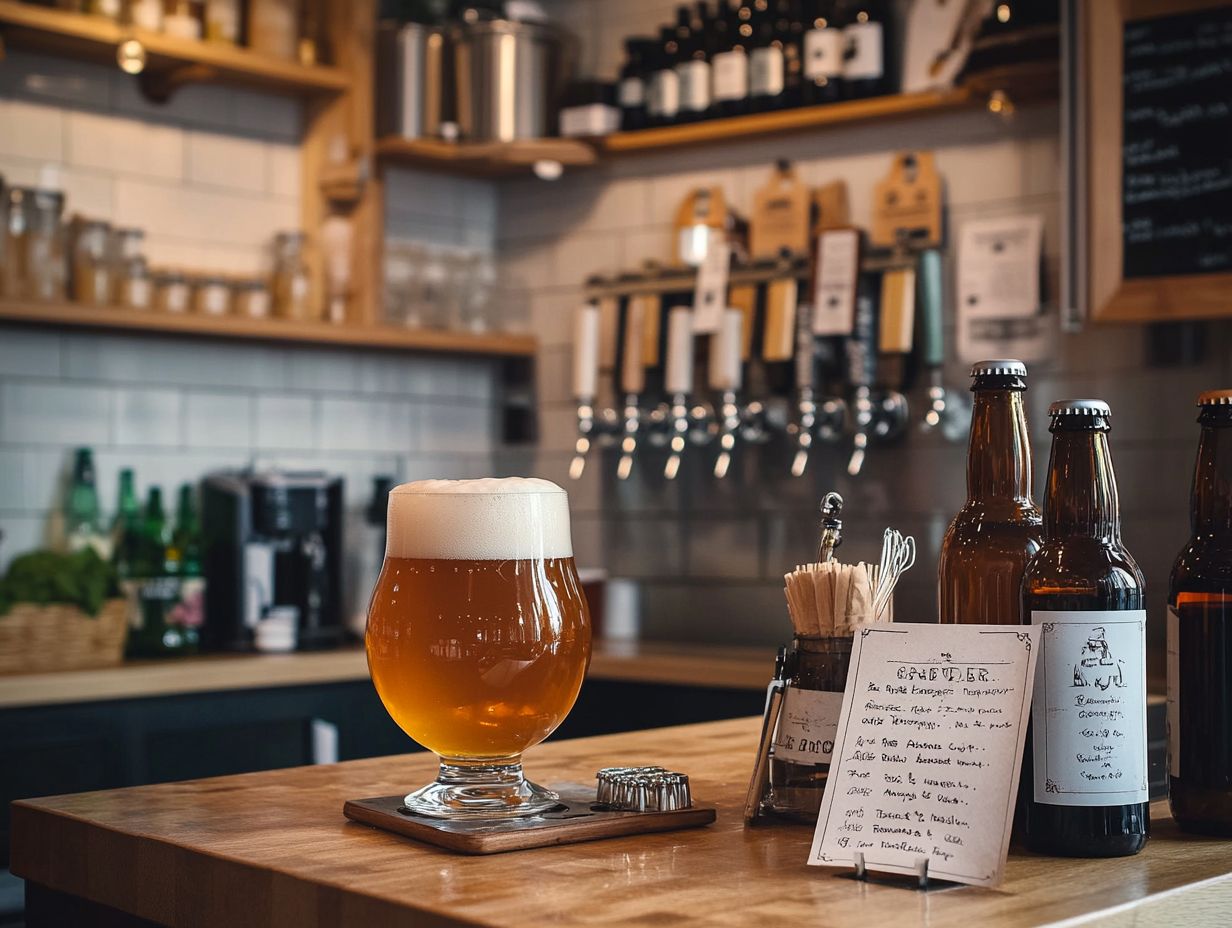
Water often takes a backseat in the brewing process, but its quality and chemistry can profoundly impact the final beer, influencing everything from flavor to brewing efficiency. Understanding the brewing history of different regions can provide insight into how water composition affects traditional beer styles.
Understanding the specific mineral content like calcium, magnesium, and bicarbonate is essential for tailoring your water to highlight or suppress distinct taste characteristics in various beer styles. For example, elevating the sulfate level can enhance the crispness in a hoppy IPA, while a balanced ratio of calcium and chloride can deliver a smoother mouthfeel in a hearty stout. Utilizing brewing software can help you track and manage these adjustments effectively.
Monitoring pH levels is critical for brewing success! Maintaining an optimal pH range promotes enzyme activity during mashing and contributes to a cleaner overall taste. If you’re aiming to elevate your brewing water, consider methods like adding specific salts or employing reverse osmosis systems to create a clean slate, allowing for precise adjustments needed to achieve your desired beer style. Taking brewing courses can provide the knowledge necessary to optimize your water chemistry effectively.
What Are the Steps to Home Brewing and Beer Brewing?
The home brewing process involves several essential steps, each one crucial in transforming raw ingredients into exquisite craft beer. You ll need to pay careful attention to each stage to ensure quality and flavor. From mashing and boiling to fermentation and carbonation, each step must be meticulously executed to create a superior final product. Utilizing brewing guides can help simplify this complex process.
- Mashing: It all begins with mashing, where the starches in the grains convert into fermentable sugars.
- Boiling: Next comes boiling, during which you add hops to impart that desired bitterness and delightful aroma.
- Fermentation: Once the wort cools down, it s time for fermentation, where yeast works its magic, converting sugars into alcohol and carbon dioxide.
- Bottling and Carbonation: The final touches involve bottling and carbonation, culminating in a beautifully crafted product that s poised for tasting and enjoyment. Engaging in local homebrew clubs can provide valuable feedback and insights during this stage.
1. Mashing and Brewing Chemistry
Mashing is the pivotal first step in your brewing journey, where you blend crushed grains with water and heat them to transform starches into fermentable sugars. This process sets the stage for everything that follows in your brewing adventure.
You ll want to pay meticulous attention to detail during this phase, particularly when it comes to maintaining specific temperatures. This optimization is crucial for the process that breaks down starches into simpler sugars. The mashing process typically takes anywhere from 60 to 90 minutes, depending on the results you re aiming for. Understanding brewing chemistry is fundamental to achieving the best results during this phase.
There are several mashing techniques at your disposal. For instance, single infusion mashing offers a straightforward method that yields clean and crisp flavors. On the other hand, step mashing involves varying the temperature at intervals, which can enhance different enzymatic processes and create a more complex flavor profile.
Each technique adds its unique touch to the final product, influencing everything from the beer s body to its smell and aroma.
2. Boiling
The boiling stage is absolutely pivotal in your brewing process, serving to sterilize the wort, extract flavors and aromas from hops, and assist in evaporating unwanted compounds. This phase is instrumental in shaping the overall character of your beer. The timing of your boil additions isn t just a formality; it significantly impacts the final bitterness and aromatic complexity.
For instance, when you add hops early in the boil, they impart bitterness that beautifully balances the malt’s sweetness. In contrast, late hopping techniques introduce those vibrant aromas without dramatically altering the bitterness. You might also explore whirlpool hopping, where you add hops at the end of the boil and let them steep in the hot wort this method allows for the extraction of those delicate flavors and aromas that can elevate your brew.
Mastering these techniques is essential for you as a brewer. By carefully manipulating boil times and methods, you can craft unique and flavorful styles of beer that truly stand out.
3. Fermentation
Fermentation is the heartbeat of the brewing process, where yeast eagerly consumes the sugars from the wort, transforming them into alcohol and carbon dioxide. This crucial stage ultimately shapes the character and flavor of your beer.
Choosing the right yeast strain is a decision of great importance, as each variety brings its own unique flavors and aromas to the table, significantly influencing the final product. For example, ale yeasts thrive in warmer fermentation temperatures, typically between 65 F and 75 F, and can produce delightful fruity esters. In contrast, lager yeasts prefer cooler environments, usually around 45 F to 55 F, resulting in a cleaner and crisper profile.
It’s essential to monitor gravity readings throughout fermentation to ensure everything is progressing smoothly and to prevent any off-flavors that can arise from prolonged fermentation or sluggish yeast activity. By managing these factors with care, you can unlock a remarkable diversity in beer styles, enhancing your enjoyment of each brew. Don t miss out on the chance to craft your own unique beer!
4. Bottling and Carbonation
Bottling and carbonation mark the final steps in your home brewing adventure, where you transfer your fermented beer into bottles and condition it to reach that perfect level of carbonation, whether through natural or forced methods.
During this critical phase, meticulous sanitation of both your bottles and equipment is vital to ward off any contamination that could compromise your hard work. If you choose the natural carbonation route, you’ll need to make precise calculations for priming sugar based on the beer’s volume and your desired carbonation levels, ensuring a balanced outcome.
On the other hand, if you’re after speed and control, forced carbonation systems offer a quicker path to bubbly perfection, making them the preferred option for many seasoned brewers.
Once your beer is bottled, it s time to focus on proper storage and aging techniques. Placing those bottles in a cool, dark environment can significantly enhance the flavor profile, allowing the various ingredients to meld harmoniously and develop delightful complexity over time.
What Are the Best Craft Beer Recipes for Home Brewing?
Crafting unique and tantalizing beers at home is an exhilarating journey, and having a collection of tried-and-true beer recipes can truly elevate your brewing experience.
Whether you’re aiming to perfect a classic IPA, a rich stout, or a refreshing Belgian Witbier, each recipe opens the door to experimentation with diverse ingredients and techniques, highlighting the remarkable versatility of craft beer and its myriad styles.
From hoppy American IPAs to fruity Hefeweizens, the possibilities for home brewers like you are virtually limitless, allowing you to indulge in and deepen your passion for beer.
1. IPA
India Pale Ale (IPA) is a beer style that has captivated the hearts of many, renowned for its intense hop flavor and aroma. If you re a craft beer enthusiast, you likely find yourself drawn to its bold and bitter profiles.
Typically, a classic IPA recipe features pale malt as its foundation, providing a light to medium body, while specialty malts contribute depth and complexity. When selecting hop varieties, you might want to consider options like Cascade, Centennial, and Citra, which are celebrated for their aromatic and flavorful contributions.
For fermentation, employing a clean, highly attenuating yeast such as American Ale (think Safale US-05) is crucial to letting those hop characteristics truly shine. The brewing process allows for delightful variations; take West Coast IPAs, for instance, known for their clarity and striking bitterness, or New England IPAs, which focus on juiciness and haziness thanks to specific yeast strains and late hop additions.
By adjusting hop timing and carefully choosing adjunct ingredients, you can significantly influence the final beer s flavor and bitterness, leading to a remarkable variety of IPAs waiting for you to explore.
2. Stout
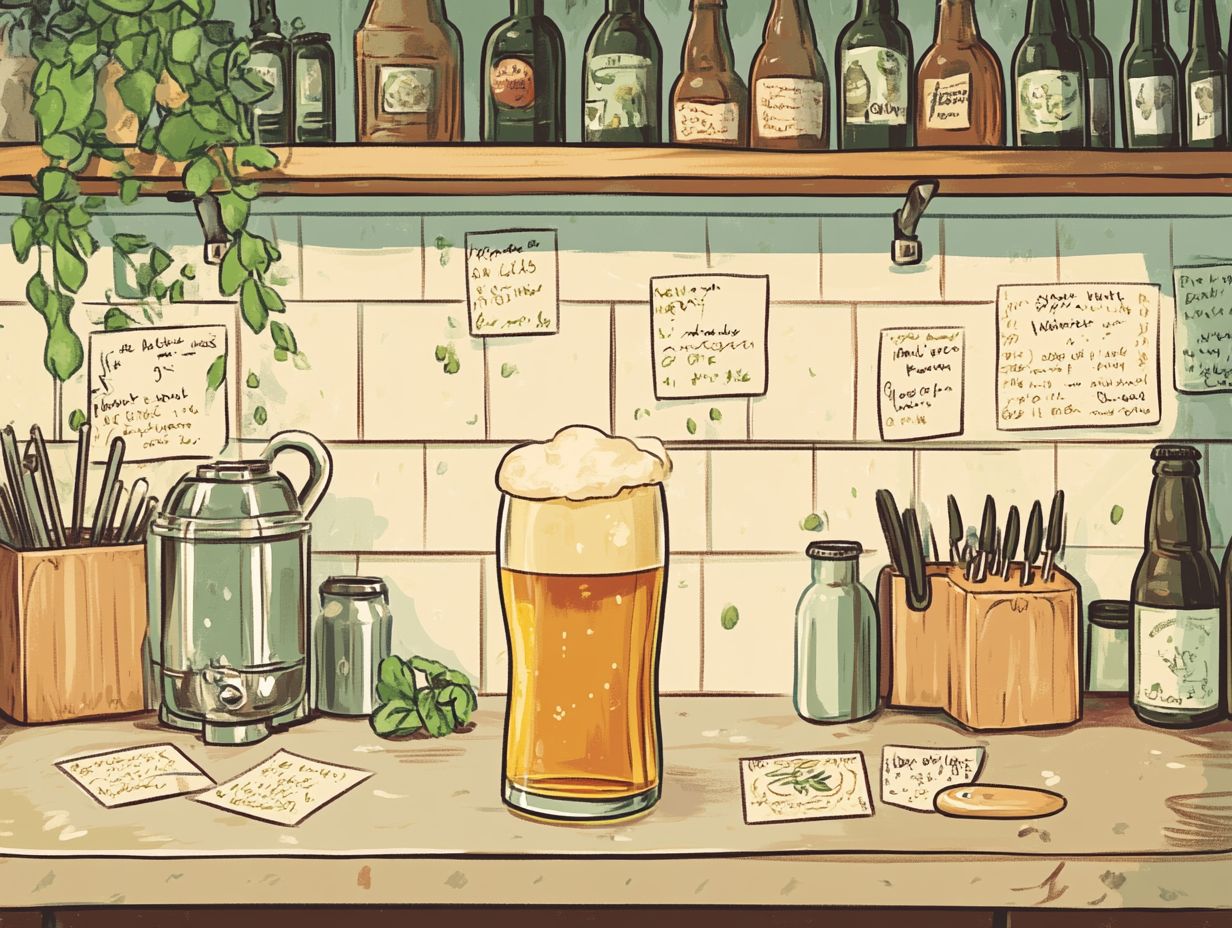
Stouts are rich, dark beers that enchant with their deep flavors of roasted malt, making them an ideal choice for anyone who appreciates robust, full-bodied craft beer.
To craft a standout stout recipe, you must pay meticulous attention to your malt selection. Start with pale malt as your base; it provides the essential fermentable sugars while beautifully complementing darker malts like chocolate, black, and roasted barley. These roasted grains are the secret behind the stout’s characteristic deep color and the intense flavors of coffee and chocolate that enthusiasts cherish.
Consider incorporating adjuncts such as oatmeal to achieve a smoother mouthfeel, especially in oatmeal stouts. If you re feeling adventurous, experimenting with higher alcohol levels in imperial stouts can elevate the overall richness.
For a truly complex flavor profile, think about integrating exquisite ingredients like vanilla, coffee, or even exploring whiskey barrel aging. Each of these can significantly contribute to that signature smooth finish, captivating both aficionados and casual drinkers alike.
3. Belgian Witbier
Belgian Witbier is your go-to refreshing, spiced wheat beer! It s perfectly crafted to deliver a delightful balance of citrus and coriander flavors just the right choice for those warm, sunny days.
To create this exquisite brew, a harmonious blend of malted wheat and pale malt lays the foundation. This results in that signature hazy appearance and a pleasingly smooth mouthfeel. The infusion of spices like coriander and orange peel, along with occasional other botanicals, enriches the flavor profile, transforming each sip into an elevated experience.
When crafting a Witbier, pay careful attention to yeast selection. This is crucial because different yeast strains contribute unique flavors and aromas to the beer. The unique Belgian yeast strains work their magic, imparting fruity esters and spicy phenols that deepen the complexity of the brew. Also, temperature control during fermentation is essential. This technique helps coax out desirable flavors while keeping any off-flavors at bay, ensuring a final product that’s nothing short of perfection.
4. Pale Ale
Pale Ales are celebrated for their exquisite balance of malt and hop character! They typically boast a moderate alcohol content and a refreshing taste that resonates with a broad audience.
The recipe for this beloved brew rests on a foundation of pale malts, delivering a light, biscuity sweetness. This sweetness harmonizes beautifully with hop bitterness. Your choice of hops can vary greatly, shaping both the aroma and flavor. American varieties often bring forth bright citrus and pine notes, while their English counterparts might introduce floral and earthy qualities.
The brewing techniques you adopt are pivotal in enhancing the ale’s overall complexity. Techniques like dry hopping, which adds hops after fermentation to intensify aroma and flavor, or making late hop additions, can significantly impact the final product. Variations like English and American pale ales showcase differences in sweetness, bitterness, and hop prominence. These variations highlight the significance of hop timing throughout the brewing journey.
5. Hefeweizen
Hefeweizen, a beloved German wheat beer, is sure to captivate your taste buds with its distinctive banana and clove flavors! It offers a refreshing and aromatic experience that is especially delightful during the summer months.
To achieve these remarkable flavor notes, brewers typically employ a specific strain of yeast, often the renowned Weihenstephan yeast. This yeast plays a pivotal role in shaping the beer’s profile during fermentation. The brewing process begins with pale malt and yeast that ferments at warmer temperatures, usually between 60 F and 75 F. This warmth fosters the creation of esters and phenols, resulting in that enchanting banana and clove aroma you love!
It’s essential to serve this brew in a traditional hefeweizen glass. This glass not only ensures proper head retention but also beautifully showcases the beer’s hazy appearance. Ideally, savor it fresh at a temperature of around 40 F to 45 F to fully appreciate its complexity.
Frequently Asked Questions
What are the essential ingredients for brewing the best craft beer?
The main ingredients for brewing the best craft beer are water, malted barley, hops, and yeast. However, you can also experiment with other ingredients like fruit, spices, and herbs to create unique flavors!
How important is the water quality in crafting the perfect beer?
Water quality plays a crucial role in brewing the best craft beer. It affects the flavor, aroma, and appearance of the final product. Make sure to use clean, filtered water for the best results!
What are some popular styles of craft beer that can be made at home?
Some popular styles of craft beer that can be made at home include:
- IPA
- Stout
- Pale Ale
- Wheat Beer
- Sour Beer
With the right ingredients and recipes, you can recreate your favorite craft beer at home!
Do I need special equipment to brew craft beer at home?
Yes! You will need some basic brewing equipment such as a large pot, fermenter, airlock, thermometer, and bottles. These can be purchased at a homebrewing supply store or online.
Can I adjust the alcohol content of my homemade craft beer?
Yes, you can adjust the alcohol content of your homemade craft beer by changing the amount of fermentable sugars and the type of yeast used. Keep in mind that a higher alcohol content may also affect the flavor and body of the beer!
Is it possible to make non-alcoholic craft beer at home?
How to Make Non-Alcoholic Craft Beer
Absolutely! You can craft delicious non-alcoholic beer at home with a special yeast that keeps the alcohol content low.
Get creative and try using everyday ingredients like kombucha or flavored sparkling water to whip up an exciting non-alcoholic alternative!

